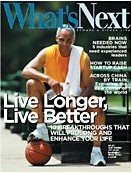 Kelly Greene has a top-notch piece Still Sexy at 60? in The Wall Street Journal (accessed here in The Pittsburgh Post-Gazette with another headline):
Kelly Greene has a top-notch piece Still Sexy at 60? in The Wall Street Journal (accessed here in The Pittsburgh Post-Gazette with another headline):A growing number of new ventures are targeting aging baby boomers, their obsessions in the final third of their lives -- and their $2 trillion in annual spending power. Start-up magazines with titles like GeezerJock, Grand and What's Next are beckoning to boomers with advice on triathlons, grandchildren or new careers.I didn't know about What's Next Magazine. Check it out. Looks like it has potential.
But golly gee … everywhere I turn I see all this motivational boomer branding silliness. Every new web site, magazine, whatever - they all have the same mundane, insulting, pandering message…
Eons: Don't Just Live Longer. Live Bigger. After 50 life becomes yours.
What's Next Magazine: Our mission ... is to encourage our readers to live bigger. To take risks and pursue their dreams.
What piles of empty nothings. I talked about this earlier, with Eons. And there is a chapter dedicated to this nuttiness in my book.
Growing Bolder has this same sort of message, has been around for awhile, and targets Boomers and older generations. It's backed up with content, a radio show, and an eclectic mix of entertaining and informative videos.
Does everybody have to copy the aspirational message of Growing Bolder?
I feel like I'm watching old TV westerns when I go to these places. As if Baby Boomers are pretty stupid and directionless and need to be rounded up, prodded, and pushed:

Move 'em on, head 'em up,
Head 'em up, move 'em out,
Move 'em on, head 'em out, Rawhide!
Wagons ….. HO!









